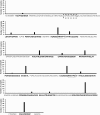Modulation of nasopharyngeal innate defenses by viral coinfection predisposes individuals to experimental pneumococcal carriage
- PMID: 25921341
- PMCID: PMC4703943
- DOI: 10.1038/mi.2015.35
Modulation of nasopharyngeal innate defenses by viral coinfection predisposes individuals to experimental pneumococcal carriage
Abstract
Increased nasopharyngeal colonization density has been associated with pneumonia. We used experimental human pneumococcal carriage to investigate whether upper respiratory tract viral infection predisposes individuals to carriage. A total of 101 healthy subjects were screened for respiratory virus before pneumococcal intranasal challenge. Virus was associated with increased odds of colonization (75% virus positive became colonized vs. 46% virus-negative subjects; P=0.02). Nasal Factor H (FH) levels were increased in virus-positive subjects and were associated with increased colonization density. Using an in vitro epithelial model we explored the impact of increased mucosal FH in the context of coinfection. Epithelial inflammation and FH binding resulted in increased pneumococcal adherence to the epithelium. Binding was partially blocked by antibodies targeting the FH-binding protein Pneumococcal surface protein C (PspC). PspC epitope mapping revealed individuals lacked antibodies against the FH binding region. We propose that FH binding to PspC in vivo masks this binding site, enabling FH to facilitate pneumococcal/epithelial attachment during viral infection despite the presence of anti-PspC antibodies. We propose that a PspC-based vaccine lacking binding to FH could reduce pneumococcal colonization, and may have enhanced protection in those with underlying viral infection.
Conflict of interest statement
The authors declared no conflict of interest.
Figures






References
Publication types
MeSH terms
Substances
Grants and funding
LinkOut - more resources
Full Text Sources
Other Literature Sources
Medical
Miscellaneous

